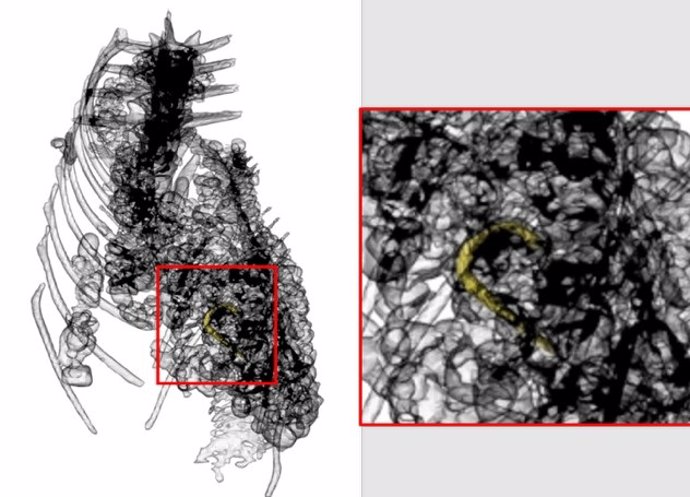Remains of the hook ingested by the crocodile – UNIVERSITY OF MANCHESTER
12 Jul. () –
Technology of cutting-edge 3D imaging have allowed us to reconstruct the life (and probable death) of a 2.2-metre-long crocodile mummified by the ancient Egyptians.
Researchers at the University of Manchester, together with Loughborough and Birmingham City Universities, revealed a freshly eaten fish still attached to its hook in the beast’s stomach, which probably ended his life.
Using specialized software in combination with X-rays and CT scanning, scientists were able to virtually extract the hook from the mummy and then construct a replica first in plastic and then cast in its original material, bronze.
The animal mummy, held at Birmingham Museum and Art Gallery and known by its accession number 2005.335, could be dated to between 2,000 and 3,000 years ago, when the practice of mummifying animals was at its peak.
The study is published in the journal Digital Applications in Archaeology and Cultural Heritage.
The crocodile had swallowed a considerable number of small stones known as gastroliths while alive to break down pieces of flesh and regulate its buoyancy.
The presence of more gastroliths in the upper part of the digestive tract, the authors say, indicates an attempt to break down the animal’s last meal. and shows that he died before they reached his stomach.
The integrity of the fish’s skeleton also suggests that was swallowed whole and had not yet been affected by the harsh digestive enzymes present in the first chamber of the crocodile’s stomach nor by the abrasive action of the gastroliths.
The apparently short time span between the fish’s ingestion and the crocodile’s death also suggests, the researchers say, that it was deliberately captured in the wild and processed for mummification as an offering to the crocodile god Sobek shortly afterward.
Healthy crocodiles were associated with fertility and abundant agriculture. The Egyptians also believed that one could protect oneself from danger by wearing clothing made from the animal’s skin.
Lead author Dr Lidija Mcknight, a research associate at the University of Manchester, said it’s a statement“Crocodile mummy 2005.335 was a unique opportunity to apply scientific analysis to the mummy of a large animal.
“Our work revealed a wealth of information, both about the crocodile’s life and the post-mortem treatment of its remains.
“Mummies have long been a source of fascination for museum visitors of all ages. Our work offers a unique opportunity to connect visitors with the history of this animal.”
He added: “While previous studies favoured invasive techniques such as unwrapping and autopsy, 3D radiography provides the ability to see inside without damaging these important and fascinating artefacts.
“We took the process a step further by replicating the hook in its original material, bronze. The Egyptians probably used a hardened clay mold into which the molten metal would have been poured, melted over a coal-based heat source.
“Although several millennia have passed between the production of the ancient fishhook and the modern replica, the casting process remains remarkably similar.”














Add Comment